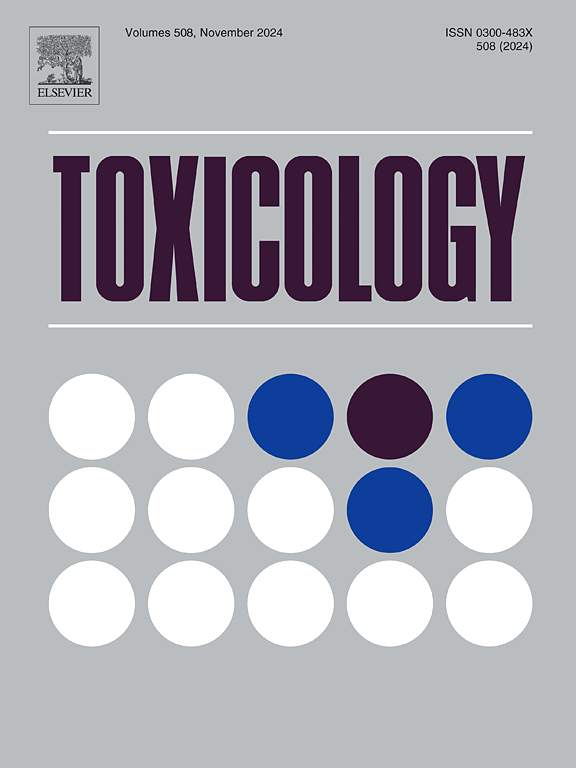Exposure to submicroplastics promotes the progression of nonalcoholic fatty liver disease in ApoE-deficient mice
IF 4.8
3区 医学
Q1 PHARMACOLOGY & PHARMACY
引用次数: 0
Abstract
Microplastics (MPs) pose emerging threats to human health, with growing concerns about liver toxicity and other harmful effects from plastic particles. While aquatic species exhibit hepatic vulnerability to micro/nanoplastics, the role of submicroplastics (100 nm-1 μm) in mammalian non-alcoholic fatty liver disease (NAFLD) progression remains unclear. We investigated the effects of a 12-week exposure to 0.5 μm polystyrene MPs (submicroplastics) in drinking water, administering this to ApoE-deficient mice fed either a chow diet (CD) or a Western diet (WD). Submicroplastics accumulated predominantly in the liver and were excreted in the feces. Histologically, submicroplastics significantly increased NAFLD activity scores, hepatic steatosis (Oil Red O-positive area), and fibrosis (Masson-positive area), with maximal severity in the WD+MPs group. Also, the MPs exposure group had increases in positive areas for F4/80 and inflammatory markers TNF-α, IL-1β and IL-6 expression under both diets. Concurrently, submicroplastics inhibited antioxidant defenses by lowering levels of superoxide dismutase and glutathione, while also increasing the lipid peroxidation marker malondialdehyde. WD-fed mice exhibited pronounced MPs-induced lipid dysregulation, including elevated hepatic triglycerides, total cholesterol, and free fatty acids (FAs). Mechanistically, submicroplastics upregulated FA synthesis regulators (ACC, FASN, SREBP1) while downregulating FA oxidation mediators (CPT1A, ACOX1, PPARα) in the livers under a WD. Our findings demonstrate that chronic submicroplastics-exposure exacerbates the progression of NAFLD in ApoE-deficient mice by disturbing lipid metabolism, enhancing oxidative stress, and amplifying inflammatory responses. This study provides experimental evidence linking environmental plastic pollution to accelerated metabolic liver disease, thereby highlighting the urgent need for plastic exposure control strategies.
暴露于亚微塑料促进apoe缺陷小鼠非酒精性脂肪肝疾病的进展
微塑料(MPs)对人类健康构成了新的威胁,人们越来越关注塑料颗粒的肝毒性和其他有害影响。虽然水生物种表现出对微/纳米塑料的肝脏脆弱性,但亚微塑料(100 nm-1 μm)在哺乳动物非酒精性脂肪性肝病(NAFLD)进展中的作用尚不清楚。我们研究了在饮用水中暴露0.5 μm聚苯乙烯MPs(亚微塑料)12周的影响,给apoe缺陷小鼠喂食鼠粮(CD)或西方饮食(WD)。亚微塑料主要在肝脏中积累,并随粪便排出体外。组织学上,亚微塑料显著增加NAFLD活性评分、肝脂肪变性(Oil Red o阳性区)和纤维化(masson阳性区),其中WD+MPs组的严重程度最大。此外,两种饮食下,MPs暴露组F4/80阳性区域和炎症标志物TNF-α、IL-1β和IL-6的表达均有所增加。同时,亚微塑料通过降低超氧化物歧化酶和谷胱甘肽水平抑制抗氧化防御,同时增加脂质过氧化标志物丙二醛。白藜芦醇喂养的小鼠表现出明显的mps诱导的脂质失调,包括肝脏甘油三酯、总胆固醇和游离脂肪酸(FAs)升高。在机制上,亚微塑料上调了FA合成调节因子(ACC, FASN, SREBP1),同时下调了FA氧化介质(CPT1A, ACOX1, PPARα)。我们的研究结果表明,慢性亚微塑料暴露通过扰乱脂质代谢、增强氧化应激和放大炎症反应,加剧了apoe缺陷小鼠NAFLD的进展。本研究提供了将环境塑料污染与代谢性肝病加速联系起来的实验证据,从而强调了塑料暴露控制策略的迫切需要。
本文章由计算机程序翻译,如有差异,请以英文原文为准。
求助全文
约1分钟内获得全文
求助全文
来源期刊

Toxicology
医学-毒理学
CiteScore
7.80
自引率
4.40%
发文量
222
审稿时长
23 days
期刊介绍:
Toxicology is an international, peer-reviewed journal that publishes only the highest quality original scientific research and critical reviews describing hypothesis-based investigations into mechanisms of toxicity associated with exposures to xenobiotic chemicals, particularly as it relates to human health. In this respect "mechanisms" is defined on both the macro (e.g. physiological, biological, kinetic, species, sex, etc.) and molecular (genomic, transcriptomic, metabolic, etc.) scale. Emphasis is placed on findings that identify novel hazards and that can be extrapolated to exposures and mechanisms that are relevant to estimating human risk. Toxicology also publishes brief communications, personal commentaries and opinion articles, as well as concise expert reviews on contemporary topics. All research and review articles published in Toxicology are subject to rigorous peer review. Authors are asked to contact the Editor-in-Chief prior to submitting review articles or commentaries for consideration for publication in Toxicology.
 求助内容:
求助内容: 应助结果提醒方式:
应助结果提醒方式:


